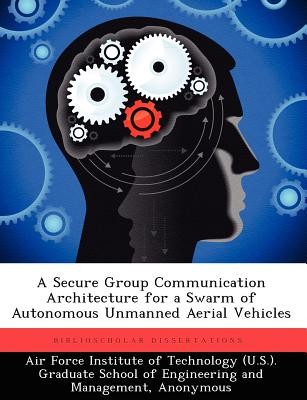
- We will send in 10–14 business days.
- Author: Adrian N Phillips
- Publisher: BiblioScholar
- ISBN-10: 1249358477
- ISBN-13: 9781249358473
- Format: 18.9 x 24.6 x 0.7 cm, softcover
- Language: English
- SAVE -10% with code: EXTRA
A Secure Group Communication Architecture for a Swarm of Autonomous Unmanned Aerial Vehicles (e-book) (used book) | bookbook.eu
Reviews
Description
This thesis investigates the application of a secure group communication architecture to a swarm of autonomous unmanned aerial vehicles (UAVs). A multicast secure group communication architecture for the low earth orbit (LEO) satellite environment is evaluated to determine if it can be effectively adapted to a swarm of UAVs and provide secure, scalable, and efficient communications. The performance of the proposed security architecture is evaluated with two other commonly used architectures using a discrete event computer simulation developed using MatLab. Performance is evaluated in terms of the scalability and efficiency of the group key distribution and management scheme when the swarm size, swarm mobility, multicast group join and departure rates are varied. The metrics include the total keys distributed over the simulation period, the average number of times an individual UAV must rekey, the average bandwidth used to rekey the swarm, and the average percentage of battery consumed by a UAV to rekey over the simulation period. The proposed security architecture can successfully be applied to a swarm of autonomous UAVs using current technology. The proposed architecture is more efficient and scalable than the other tested and commonly-used architectures. Over all the tested configurations, the proposed architecture distributes 55.2 - 94.8% fewer keys, rekeys 59.0 - 94.9% less often per UAV, uses 55.2 - 87.9% less bandwidth to rekey, and reduces the battery consumption by 16.9 - 85.4%.
EXTRA 10 % discount with code: EXTRA
The promotion ends in 17d.14:04:14
The discount code is valid when purchasing from 10 €. Discounts do not stack.
- Author: Adrian N Phillips
- Publisher: BiblioScholar
- ISBN-10: 1249358477
- ISBN-13: 9781249358473
- Format: 18.9 x 24.6 x 0.7 cm, softcover
- Language: English English
This thesis investigates the application of a secure group communication architecture to a swarm of autonomous unmanned aerial vehicles (UAVs). A multicast secure group communication architecture for the low earth orbit (LEO) satellite environment is evaluated to determine if it can be effectively adapted to a swarm of UAVs and provide secure, scalable, and efficient communications. The performance of the proposed security architecture is evaluated with two other commonly used architectures using a discrete event computer simulation developed using MatLab. Performance is evaluated in terms of the scalability and efficiency of the group key distribution and management scheme when the swarm size, swarm mobility, multicast group join and departure rates are varied. The metrics include the total keys distributed over the simulation period, the average number of times an individual UAV must rekey, the average bandwidth used to rekey the swarm, and the average percentage of battery consumed by a UAV to rekey over the simulation period. The proposed security architecture can successfully be applied to a swarm of autonomous UAVs using current technology. The proposed architecture is more efficient and scalable than the other tested and commonly-used architectures. Over all the tested configurations, the proposed architecture distributes 55.2 - 94.8% fewer keys, rekeys 59.0 - 94.9% less often per UAV, uses 55.2 - 87.9% less bandwidth to rekey, and reduces the battery consumption by 16.9 - 85.4%.


Reviews